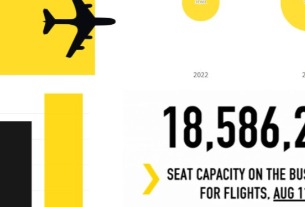
The airline industry is experiencing a massive overhaul, transforming its value chain to embrace new technologies and shifting customer expectations. This shift is critical in order to scrap outdated and clunky legacy systems that create headaches for staff and passengers alike.
Now, airlines are moving towards more flexible, real-time, and future-ready cloud-native solutions.
For Newbies: What Is Revenue Management?
Airlines' revenue management role is to analyze and forecast the demand for each flight and set prices accordingly.
This job involves using complex statistical models and historical data to forecast the demand for each flight and then setting optimal prices for each seating class. Modern revenue management systems consider not only historical data but also future data. Future data can include a variety of different sources, such as social media activity, search and weather data. By analyzing this data in real-time, airlines and their pricing algorithms can gain a more comprehensive understanding of customer demand and market conditions, and adjust pricing and inventory levels even better.
The result of this process is a finely tuned pricing strategy that fills as many seats as possible without risking over- or underbooking. This helps airlines optimize their revenues by selling more seats at higher prices during peak periods and selling fewer seats at lower prices during off-peak periods.
In a nutshell, revenue management plays a critical role in the financial success of airlines, helping them increase revenue, reduce costs, and maximize profitability. With robust data feeds that allow real-time pricing adjustments on the fly, airlines can better manage their resources and stay competitive.
The Role of Dynamic Pricing
Dynamic pricing has long been a key component of revenue management for airlines. It allows them to adjust prices based on changes in demand and other market factors.
For airlines, dynamic pricing means that ticket prices can change frequently based on various factors, such as adjustments in capacity and flight frequencies, competitors' routing, time of day, day of the week, seasonality, and even the weather. For example, if demand for a particular flight is high, the airline may increase the price of the remaining seats to maximize revenue. Conversely, if demand is low, the airline may lower the price of the remaining seats to attract more customers.
Dynamic pricing helps airlines achieve a more optimal balance between supply and demand. By constantly adjusting prices based on market conditions, airlines can maximize their revenues and fill as many seats as possible. This is especially important in the highly competitive airline industry, where profit margins are often slim and demand can fluctuate rapidly.
From Dynamic To Continuous Pricing
Continuous pricing refers to the practice of adjusting prices dynamically and continuously in real-time based on changes in demand, supply, and a plethora of external market factors. This approach to revenue management is more fluid than traditional revenue management techniques, which rely on fixed pricing structures and periodic adjustments.
Continuous pricing represents a fundamental shift in revenue management, enabling airlines to maximize the value of each transaction by making precise pricing decisions based on real-time data and market conditions. To achieve this, airlines need to overcome the challenge of managing data flows from multiple sources, while ensuring accuracy by removing anomalies and inaccuracies. Building sophisticated revenue management systems is crucial to implementing continuous pricing, enabling airlines to offer more targeted and relevant products and services to their customers. This is particularly important in liberating clients from the constraints of legacy fare filing and traditional inventory controls, clearing the way for true real-time pricing and offer management. By embracing continuous pricing and optimizing their revenue management systems, airlines can increase their competitiveness and conversion rates, ultimately driving profitability and success in a fast-changing market.
Read original article




